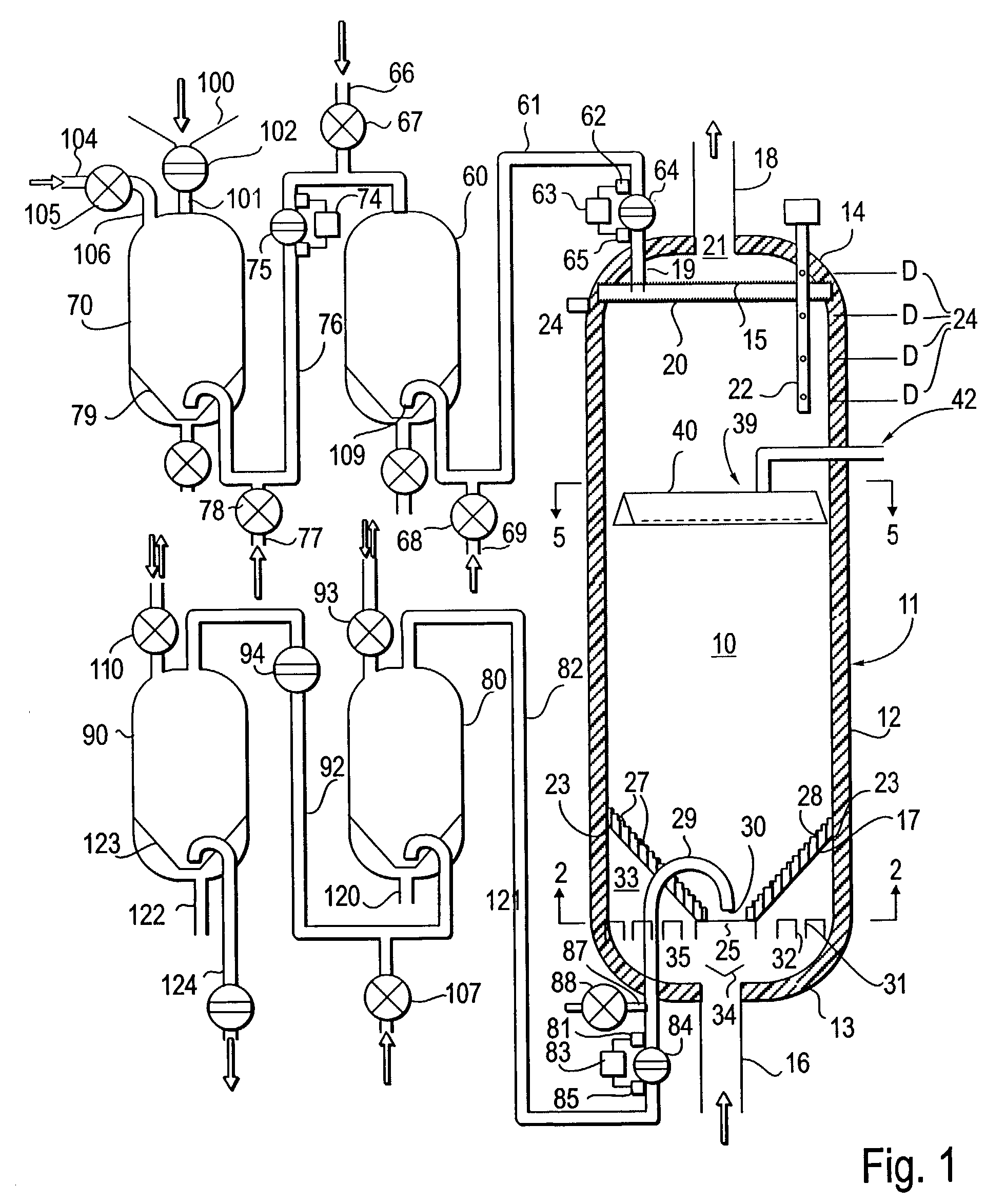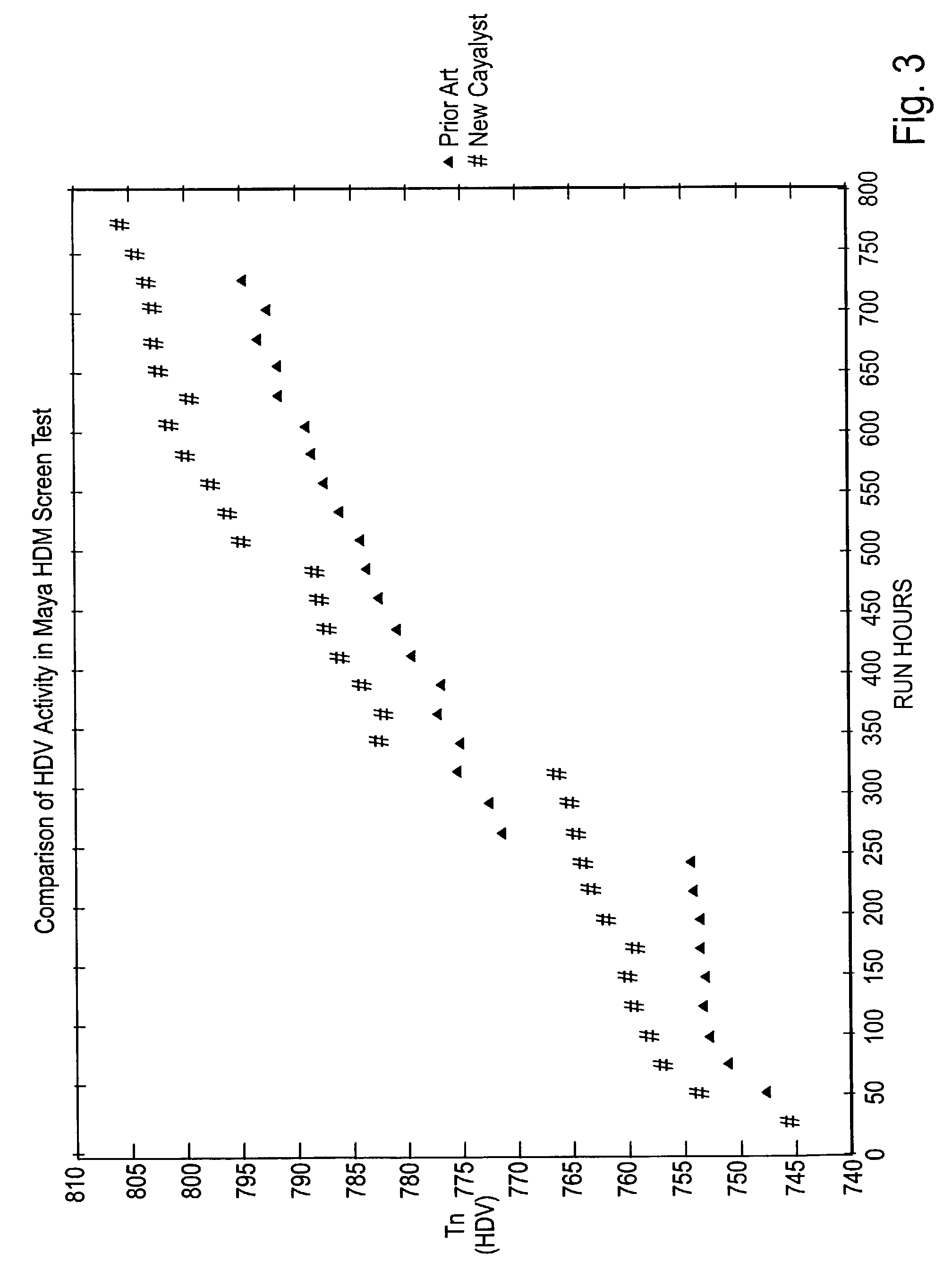Catalyst for conversion processes
a technology of catalysts and conversion processes, applied in the field of catalysts, can solve the problems of high cost of replacement of catalysts, high cost of vessels capable of containing such a reaction process, and high cost of pumps, piping and valves for handling fluid streams containing hydrogen at such pressures and temperatures, and achieve the effect of dramatic extension of the life of the second stage catalys
- Summary
- Abstract
- Description
- Claims
- Application Information
AI Technical Summary
Benefits of technology
Problems solved by technology
Method used
Image
Examples
example 1
Catalyst Preparation
[0082]A supply of alumina spheres (0.10 inch diameter) was obtained. This material had a peak pore diameter, as measured by nitrogen porosimitry of 160.
[0083]A sample of these spheres was placed in a calcining furnace at 1750° F. for 1 hour in dry air. The peak pore diameter was reduced to 135. The support had a surface area by (N2 desorption) of 150 m2 / g and a bulk density of 0.72 g / cc.
[0084]Other portions of the alumia spheres were calcined for longer or shorter periods which reduced the average pore diameter further or less. This provided an array of supports having the following pore diameters.
Support Peak Pore Diameter
[0085]75[0086]115[0087]135[0088]150[0089]160
[0090]These materials were each made into a hydroprocessing catalyst by adding nickel, molybdenum and phosphorus.
[0091]In a representative laboratory scale preparation; 177.75 grams of the alumia support (135 peak diameter) was rehydrated in water overnight.
[0092]The rehydrated support was separated f...
example 2
Hydroprocessing Testing
[0101]120 cc's of the catalyst prepared as in Example 1 were charged to a pilot scale hydroprocessing reactor. The unit was operated in an upflow manner with a hydrogen pressure of 2000 psig and two pre-selected reactor temperatures of 713 F. and 755 F. over the course of a 750 hour test. The initial sulfur concentration in the feed was 4.44 wt % and it was reduced to 1.67% at 755 F. after 600 run hours. The initial vanadium concentration in the feed was 358 ppm, and it was reduced to 158 ppm.
[0102]A similar run was conducted using commercial catalyst with similar chemical composition but different pore diameter. In this run, initial feed sulfur of 4.44 wt % was reduced to 1.90% at 755 F. after 600 run hours; vanadium of 358 ppm in the feed was reduced to 137 ppm.
[0103]The results of this comparative test are given in FIGS. 2 and 3 as the temperature requirement of each catalyst to maintain a constant conversion of either sulfur or vanadium. It is shown that i...
PUM
| Property | Measurement | Unit |
|---|---|---|
| pore diameter | aaaaa | aaaaa |
| diameter | aaaaa | aaaaa |
| particle density | aaaaa | aaaaa |
Abstract
Description
Claims
Application Information
 Login to View More
Login to View More - R&D
- Intellectual Property
- Life Sciences
- Materials
- Tech Scout
- Unparalleled Data Quality
- Higher Quality Content
- 60% Fewer Hallucinations
Browse by: Latest US Patents, China's latest patents, Technical Efficacy Thesaurus, Application Domain, Technology Topic, Popular Technical Reports.
© 2025 PatSnap. All rights reserved.Legal|Privacy policy|Modern Slavery Act Transparency Statement|Sitemap|About US| Contact US: help@patsnap.com



